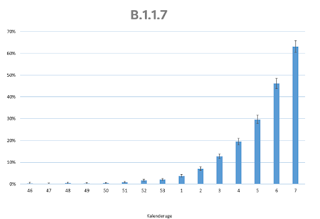SSI: COVID Variant B.1.1.7 Now Dominant In Denmark - Increases Risk of Hospitalization 64%

#15,831
In early January, in (SSI) Estimate Of COVID Variant B.1.1.7 Growth, Denmark's Statens Serum Institut warned that if he epidemic curve could not be substantially slowed, the B.1.1.7 COVID variant would become the dominant COVID lineage in Denmark by the end of February.
(excerpt)
It is the health authorities' assessment that it is crucial to turn the epidemic curve around and get the contact number significantly below 1 in the coming weeks, so that the infection rates are as low as possible when cluster B.1.1.7 becomes the dominant virus in mid-February. As large parts of society have been shut down, it is expected that infection can occur to a greater extent in connection with gatherings inside and outside the home, and that tightening the assembly ban from 10 to 5 people in the public space is a necessary measure to prevent serious spread of infection.
In all but their best case scenario, they considered it likely that it was simply a matter of `when' . . . not `if' . . . variant B.1.1.7 becomes dominant in Denmark.
Two weeks later, the UK released a NERVTAG paper on COVID-19 variant B.1.1.7 that foundthere is a realistic possibility that VOC B.1.1.7 was associated with an increased risk of death compared to non-VOC viruses.
They estimated the increased risk at that time to be about 30%.
Just two weeks ago, in an Updated NERVTAG Report, additional UK studies reinforced the notion that B.1.1.7 likely carries somewhere between a 30%-70% increased risk of death.
This combination of increased severity and infectivity has raised concerns that the recent gains made against the COVID pandemic could become short-lived should this variant continue its world tour.
Overnight Denmark's SSI published new data showing that B.1.1.7 has become the dominant COVID lineage in Denmark and data suggesting that infection with this variant carries a 64% greater risk of hospitalization.
As predicted by mathematical model calculations, B.1.1.7 has now been taken over as the most widespread variant in Denmark. Now, results from a Danish study show that B.1.1.7 also seems to carry a 64% greater risk of hospitalizations (95% safety interval 32-104%).
Last edited on February 24, 2021

Due to greater infectivity, the proportion of those infected with the B.1.1.7 variant has been steadily growing and is today dominant in Denmark.
There is good reason to take the virus variant B.1.1.7 seriously. Calculations of the variant made by the expert group for mathematical modeling at the Statens Serum Institut (SSI) have since the turn of the year predicted that an undercurrent of infection with the more infectious variant would take over and drive the epidemic in Denmark during February.
Those predictions have proven to hold true. The proportion of people infected with B.1.1.7 increased from 4% in early January to 45% in the second week of February. And B.1.1.7 now accounts for over 60% of the total infection.
Now, the results of a registry-based study conducted by SSI show that people infected with B.1.1.7 have an estimated increased risk of hospitalization compared to people infected with other SARS-CoV-2 virus variants of 64% (95 safety range 32-104%).
"We do not know the explanation for the fact that B.1.1.7 increases the risk of being admitted. But our figures point in the same direction as several other studies from the UK, which show that B.1.1.7 may have more serious courses, ”says Tyra Grove Krause, Acting Technical Director at SSI.
Results agree with UK studies
On 11 February, the UK authorities published a reportsummarizing data from several studies suggesting that infection with B.1.1.7 may lead to more serious disease compared to other SARS-CoV-2 virus variants.
“It is important to emphasize that SARS-CoV-2, including B.1.1.7, in the vast majority of cases produces mild processes. In the study, 6% of the cases with B.1.1.7 were admitted. However, if the risk of hospitalization is greater for B.1.1.7, hospitals may become more congested as B.1.1.7 spreads more. ” says Tyra Grove Krause.
On 11 February, the UK authorities published a reportsummarizing data from several studies suggesting that infection with B.1.1.7 may lead to more serious disease compared to other SARS-CoV-2 virus variants.
“It is important to emphasize that SARS-CoV-2, including B.1.1.7, in the vast majority of cases produces mild processes. In the study, 6% of the cases with B.1.1.7 were admitted. However, if the risk of hospitalization is greater for B.1.1.7, hospitals may become more congested as B.1.1.7 spreads more. ” says Tyra Grove Krause.
Vaccines are considered effective
A total of 35,887 individuals who tested positive for SARS-CoV-2 in the period from January 1 to February 6 were included in the study. Samples from 23,057 (64%) individuals were sequenced throughout. Here, a virus genome was detected for 18,499 (80%). Among these, 2,155 (12%) were infected with B.1.1.7.
A total of 128 out of 2,155 B.1.1.7 cases were admitted. People infected with B.1.1.7 had an increased risk of hospitalization of 64% (95% confidence interval 32% -104%) compared to those infected with other virus variants, taking into account differences in age and time of sampling for B.1.1.7 cases and cases with other variants as well as a number of other factors.
“The results emphasize that we must continue to pay attention to preventing infection with SARS-CoV-2 in general in society until we have the vaccines spread to more people in the coming months. Fortunately, the international health authorities consider that the current COVID-19 vaccines are effective against B.1.1.7 ", says Tyra Grove Krause.
The Danish surveys have today been submitted to an international preprint server. This means that the study has not yet been reviewed by peers in peer-review or assumed in a scientific journal, but that the article will meanwhile be publicly available within a few days.
In January the CDC's MMWR made a similar forecast for the United States, suggesting that B.1.1.7 could become dominant here by late March or April (see Emergence Of SARS-CoV-2 B.1.1.7 Lineage — United States, Dec 29, 2020–Jan 12, 2021).
As problematic as B.1.1.7 appears to be, the saving grace is that the current vaccines appear to be effective against it. The more people that can be vaccinated now - before this variant becomes dominant - the better chance we have of blunting its impact.
Admittedly, there are other variants of concern (e.g. B.1.351, P.1, CAL.20C, etc.) that may not be as well controlled by current vaccines, which could begin to gain traction should B.1.1.7 recede. But for now, B.1.1.7 remain as our variant of most immediate concern.
